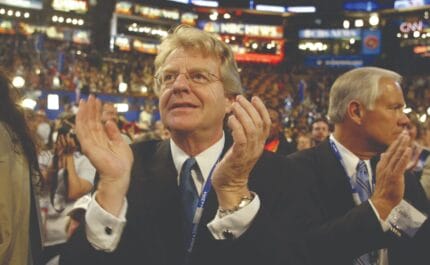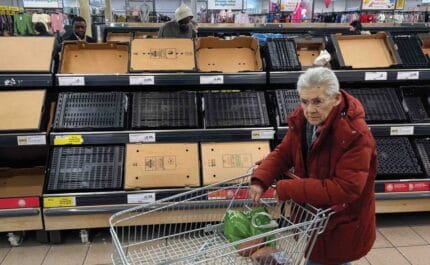“We remember them”
The shooting in Orlando’s Pulse nightclub on Sunday 12th June was the worst massacre of gay people in US history. Until then that horrible distinction had been held by an arson attack at the UpStairs Lounge, a New Orleans bar, in 1973. Two tragedies, four decades apart, but a world away in how society responded to them: Orlando prompted global unity and defiance – but after the UpStairs Lounge attack many survivors couldn’t even tell their loved ones they were there. Chris Bourn told the story of a silent tragedy
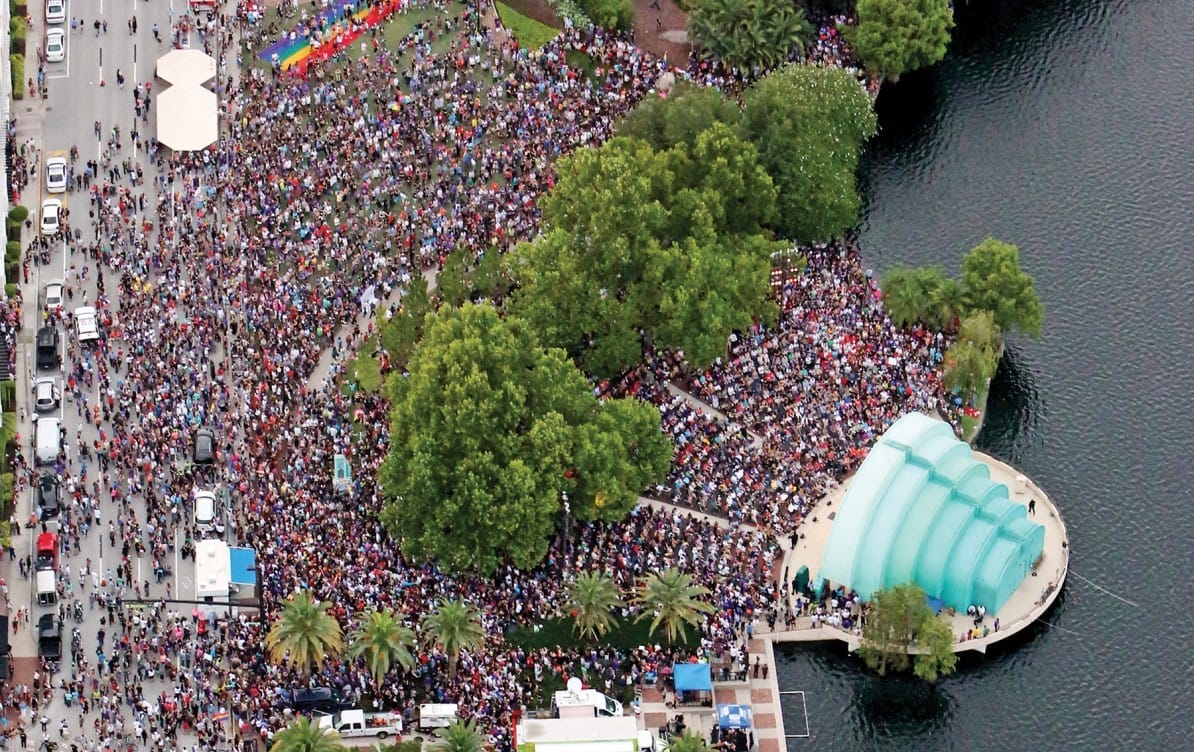
An outpouring of people attend a vigil for the Pulse nightclub shooting in Orlando on 19th June. Photo: TNS/SIPA USA/PA Images
12th June 2016 (Taken from: #23)
When Omar Mateen walked through Orlando’s Pulse nightclub spraying bullets in the early hours of Sunday 12th June he killed 49 people and wounded 53 more. It was the worst massacre of gay people in living memory – and the deadliest mass shooting in US history. For three hours the world’s media fixated on the horrifically bloody siege; it was reported as yet another in a succession of “lone-wolf” terrorist atrocities committed as a display of fealty to Isis, and Mateen’s actions prompted widespread revulsion, condemnation – and solidarity.
Global support for Orlando’s LGBT community was overwhelming. Landmarks from the Eiffel Tower to the Sydney Harbour Bridge were lit up in rainbow colours. Four days after the shooting, the president of the United States paid a visit to Orlando, laid flowers at a makeshift shrine to the victims and, in his words, “held and hugged grieving family members and parents”. Even the Pope – leader of a Catholic Church whose official position on sex between people of the same gender remains that it is “contrary to the natural law” – was moved, according to a Vatican statement released within hours of Mateen’s death in a shootout with a police SWAT team, to “the deepest feelings of horror and condemnation, of pain and turmoil before this new manifestation of homicidal folly and senseless hatred.”
Reflecting on this worldwide display of support, Seth Rudetsky, a New York radio host and acclaimed musician and writer on Broadway, told me that “the LGBT community everywhere, not just in Orlando, feels brought together… not in hate towards the perpetrator but in love – wanting to support the victims and their families.”
Rudetsky’s own contribution was to hit his contacts book and corral America’s musical-theatre industry into action. On 20th June, barely a week after the attack, a benefit song had been recorded and released featuring 60 of the biggest names on Broadway, including Whoopi Goldberg, Sarah Jessica Parker and Nathan Lane. The suggestion of a star-studded charity single had come from Rudetsky’s husband, producer James Wesley. “He woke me up, told me the idea and said we had to do it as quickly as possible because, sadly, the world forgets about tragedies – because there’s always another one.”
In 2016 the names of each of those killed were solemnly read aloud by city officials to 50,000 people chanting ‘We remember them’”
In its first week alone the Broadway for Orlando song raised $80,000 for the GLBT Community Center of Central Florida to help pay for funeral expenses, grief counseling and treatment for PTSD for victims and their families. The song chosen was a cover of Bacharach and David’s What the World Needs Now Is Love. And the distinctive voice heard on the second line – “It’s the one thing that there’s just too little of…” – was that of Carole King.
Over four decades ago, her voice would have been very familiar to the victims of the previous biggest mass murder of gay people in American history: a horrific arson attack which took place at a New Orleans bar on 24th June 1973. That week’s Billboard magazine listed King’s single Believe in Humanity – a Stevie Wonder-influenced funk-pop plea for peace, released just as public attention was swinging from Vietnam to Watergate – as a Top Single Pick, following heavy radio airplay throughout June.
It might even have been played on the jukebox that night. Regulars at the UpStairs Lounge, a thriving gay hangout in the city’s French Quarter, were always encouraged to bring their own vinyl, mostly new releases, to provide the music at the bar. During the establishment’s Sunday evening “beer busts”, though, the records were often drowned out by showtunes bashed out on the piano. These happy hour blowouts were a popular draw for the discreet gay crowd for whom the bar had become a relaxed, friendly haven since it opened three years before.
Johnny Townshend, who published a book on the UpStairs Lounge fire entitled Let the Faggots Burn, says that beyond the bohemian bubble of the French Quarter, it was still “a terrible thing” to be gay in the southern United States. “It was still just a couple of years after the raids on bars had stopped,” he says, referring to the discriminatory police actions that had prompted the Stonewall riots in Greenwich Village, New York, four years – almost to the day – before the UpStairs Lounge fire. “You could be at a bar, there would be a raid, your name would be published in the paper the next morning and you’d lose your job. So sometimes people, once they were arrested, would go home and pack up and leave town before the paper came out the next day.”
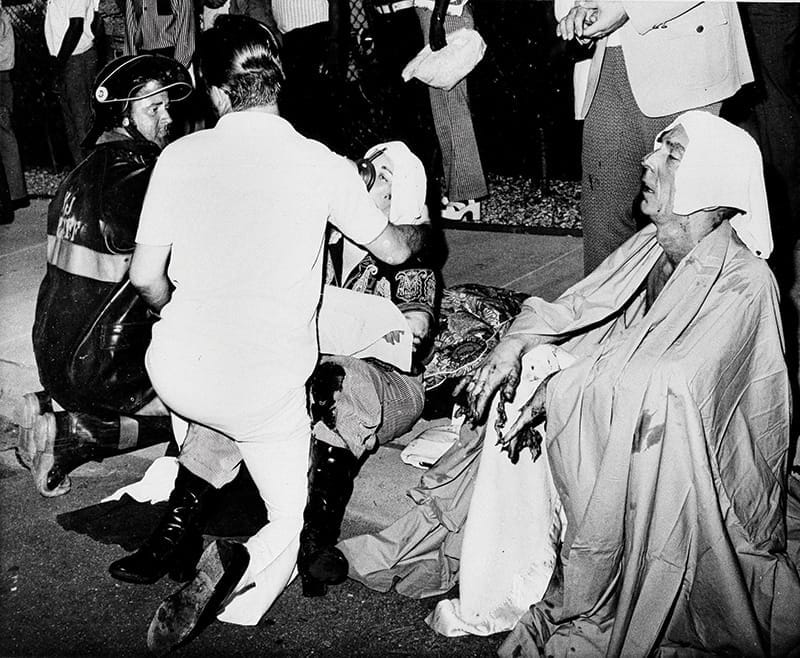
Firemen give first aid to survivors of the UpStairs Lounge fire. Photo: G.E. Arnold/AP/Press Association Images
As well as the convivial drinkers on that sweltering Sunday, the bar was hosting a meeting of the New Orleans branch of the Metropolitan Community Church, a mission set up so that gay Christians – universally rejected from mainstream denominations at the time – could worship openly with those who shared their faith. For the bartender on duty, Buddy Rasmussen, it had been a busy shift already, and it had only just turned eight o’clock.
Which is possibly why he survived. When the door buzzer went – cab drivers and delivery people would usually buzz for attention from the street entrance a storey below – Buddy, either too busy or too weary to go himself, sent a regular to answer it. On opening the door at the top of the stairwell, the man was blasted back into the bar by a fireball, which swept through the room, igniting the curtains, the furniture and the people who rushed to escape it. Twenty minutes later, 29 of the estimated 65 people in the bar had burned to death, some completely incinerated. A further three died in hospital. In terms of loss of life, it was the single worst New Orleans fire in living history. And yet, once the firefighters had left the scene, it was largely ignored.
In 1973 neither Louisiana’s governor nor the New Orleans mayor at the time ever made a public statement about the shocking loss of life”
In part, this was because many of the survivors didn’t want to talk about the attack – it would have meant admitting they had been at a gay bar to their families or employers. They had to suppress the horror they had experienced and carry on as if nothing had happened. One member of the MCC congregation, Duane George Mitchell, who had escaped with a group whom Rasmussen had led to safety on the roof of an adjoining building, went back in to rescue his partner; their bodies were later found clinging together, fused by the flames. In 2013, Mitchell’s son Duane, then aged 51, told Time: “We didn’t even know that he was gay… A lot of people didn’t even claim their relatives’ bodies… I guess they were so ashamed of it.” Shame – or at least the fear of ostracism – ran so deep in New Orleans society in the ’70s, in fact, that three of the dead were never identified. Their remains ended up in the same grave in a pauper’s cemetery next to City Park, the burial paid for by an anonymous donor.
In 2016, at the 19th June memorial service for the victims of the Pulse shooting, the names of each of those killed were solemnly read aloud by city officials to 50,000 people chanting “We remember them”: in 1973, in contrast, neither Louisiana’s governor nor the New Orleans mayor at the time, Moon Landrieu, ever made a public statement about the shocking loss of life at the UpStairs Lounge. It wasn’t until the fire flickered briefly back into public consciousness at its 40th anniversary in 2013 that city authorities finally acknowledged it, with the current mayor, Landrieu’s son Mitch, issuing a belated certificate of commemoration.
For those who did register at the time that there had been a tragedy, the image that stayed with them was a photograph taken while investigators were still on the scene of the MCC group’s pastor, Bill Larson, hanging out of the first-floor window, his charred body left in full view of passers-by for hours. “It’s the most horrific image from the whole fire,” says Townshend. “If you look carefully, you can see he’s breaking through the actual window trying to get out; it kept sliding down shut every time he lifted it because the ropes that held the weight were rotten. And he’s just trapped where he burned to death.”
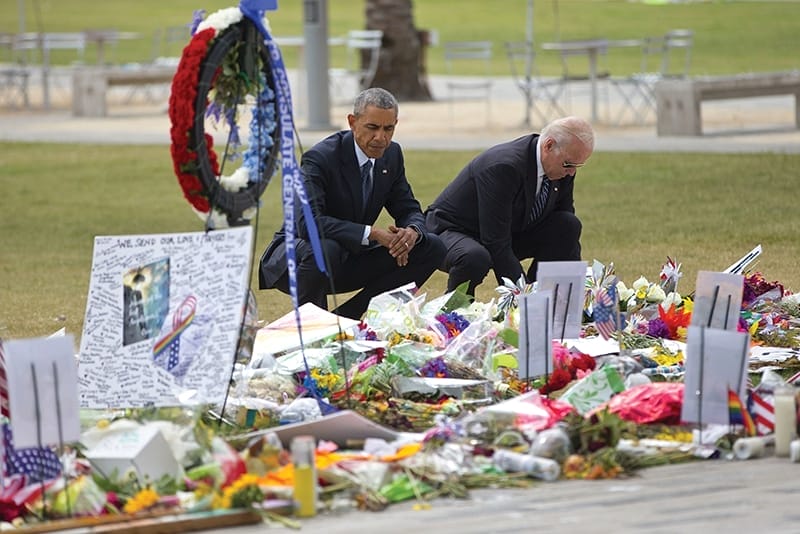
US president Barack Obama and vice president Joe Biden visit a memorial to the victims of the Pulse shooting on 16th June. Photo: Pablo Martinez Monsivais/AP/Press Association Images
Outside New Orleans, the only national coverage the fire received was a one-minute report on CBS news (which characterised the bar as “a hangout for homosexuals”). Locally, it received more attention and led the front page of the New Orleans States-Item the next day. But as shocking as the story was, it wasn’t enough to stir Larson’s fellow ministers into showing much sympathy for the victims. “After the fire it was very difficult to find any churches willing to hold even a memorial service,” says Townshend. One who did, Reverend Bill Richardson, was admonished for it by the Episcopal church bishop of New Orleans, and quickly became a target of hate mail. “A lot of churches,” says Townshend, “wouldn’t even bury the dead because they died in a gay bar.”
Townshend is from New Orleans, and remembers the fire being reported as an 11-year-old, though he didn’t know the UpStairs Lounge as a gay bar until he came out himself years later. “Having grown up in the South and in the Mormon community, I certainly knew there were lots of people who didn’t like gays,” he says, but in the case of the UpStairs Lounge, “just the degree of indifference was shocking to me”.
Townshend spoke to the survivors back in 1989 and 1990, but his book wasn’t published until four years ago, in 2012 – although this wasn’t necessarily down to apathy. “A lot of the problem I had with going to publishers back in the day,” he explains, “was people would say, ‘You know, it was a terrible thing but you can’t show that anything good came out of it. You didn’t change the fire codes – nothing changed because of it.’ They found the story unsatisfying.”
“But you know, we didn’t learn anything from the UpStairs Lounge,” he continues, “so are we going to learn something from the Pulse shooting? Let’s learn something. To me, the lesson is that we definitely need tighter gun regulations. At the UpStairs Lounge, 32 people were killed and there was no gun involved, it was just a can of lighter fluid. People are always going to be able to kill. It’s just so much easier to do with guns.”
Orlando shooter Omar Mateen’s motives remain in doubt – the FBI has so far been reluctant to confirm that he was really acting out an Islamic terrorist fantasy, and have been unable to fully discount rumours that he was, in fact, gay himself and a regular at Pulse.
After the UpStairs Lounge attack, meanwhile, they didn’t even identify the murderer. Investigators found a canister of lighter fluid at the scene, and the most intense suspicion fell on Roger Nunez, a patron of the bar who had been involved in an altercation that ended with a punch to his jaw around half an hour before the fire was set. A survivor of the fire reported hearing Nunez say, “I’m going to burn y’all out,” as he left the bar – and he’s said to have confessed to friends while drunk that he was responsible.
Police questioned him twice in the months that followed but nothing came of it. A year later Nunez committed suicide. “If this fire had happened at an upscale white restaurant in the French Quarter, something would’ve been done about it,” says Townshend. “It was not a priority because of who the victims were.” The combination of reticence on the part of survivors, apathy from mainstream ’70s society and the lack of a culprit and court case to perpetuate the story ensured the UpStairs disaster quickly sank into deep obscurity. “I think it was in 1990, one of the museums downtown was doing an exhibit on great fires of New Orleans,” recalls Townshend, “and they mentioned two fires that wiped out half the French Quarter. But in this history of important fires of New Orleans the one that had the largest death toll of any in the history of the city was not mentioned. I don’t know that it was a deliberate slap in the face to gay people – I just think it wasn’t remembered.”
Amid the outpouring of sympathy and support in the wake of the Orlando shooting, it might seem that this kind of collective amnesia just wouldn’t be possible in 2016. But, like Seth Rudetsky and James Wesley, Townshend has his doubts. “We have so many mass shootings here, we can’t keep track of them,” he says. “There will be another one next month and other things will take its place in people’s consciousness.”
And at ground level, Townshend points out, the disdain for LGBT people still simmers. When he was researching his book, Buddy Rasmussen, the UpStairs Lounge’s bartender who survived the fire spoke to him, “freely when he was in New Orleans. But he moved to a little bitty town in Arkansas about 20 years ago. He never wants to talk about it any more because he’s afraid people in his town are going to find out he’s gay. So even today people are afraid. He’s in his 70s.”
If the message hasn’t yet got through to small-town society, at least, says Seth Rudetsky, the world’s rush to support the victims in Orlando is a signal that unequivocal acceptance is becoming more and more a reality for people living LGBT lives. “We’re hoping,” says Rudetsky, “that any gay kids out there who are feeling alone and afraid because of the shooting can know that there is a whole community of wonderful people all over the world who love and support them.”
Slow Journalism in your inbox, plus infographics, offers and more: sign up for the free DG newsletter. Sign me up
Thanks for signing up.
